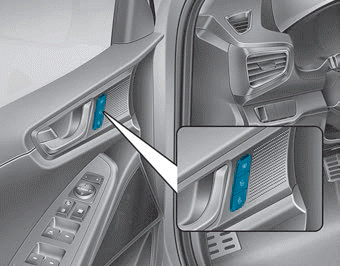Symptom
|
Suspect area
|
Remedy
|
Engine misfire with abnormal internal lower engine noises.
| Worn crankshaft bearings.
Loose or damaged engine drive plate.
| Replace the crankshaft and bearings as required.
Repair or replace the drive plate as required.
|
Worn piston rings.
(Oil consumption may or may not cause the engine to misfire.)
| Inspect the cylinder for a loss of compression.Repair or replace as required.
|
Worn crankshaft thrust bearings
| Replace the crankshaft and bearings as required.
|
Engine misfire with abnormal valve train noise.
| Stuck valves.
(Carbon buildup on the valve stem)
| Repair or replace as required.
|
Excessive worn or mis-aligned timing chain.
| Replace the timing chain and sprocket as required.
|
Worn camshaft lobes.
| Replace the camshaft and valve lifters.
|
HLA sponge
| Run the engine at 2500 - 3000rpm within 15 minutes.
If it dosen't disappear, refer to cylinder head assembly in this group.
|
Engine misfire with coolant consumption.
| | •
| Faulty cylinder head gasket and/or cranking or other damage to the cylinder head and engine block cooling system. |
| •
| Coolant consumption may or may not cause the engine to overheat. |
| | •
| Inspect the cylinder head and engine block for damage to the coolant passages and/or a faulty head gasket. |
| •
| Repair or replace as required. |
|
Engine misfire with excessive oil consumption.
| Worn valves, guides and/or valve stem oil seals.
| Repair or replace as required.
|
Worn piston rings.
(Oil consumption may or may not cause the engine to misfire)
| | •
| Inspect the cylinder for a loss of compression. |
| •
| Repair or replace as required. |
|
Engine noise on start-up, but only lasting a few seconds.
| Incorrect oil viscosity.
| | •
| Install the correct viscosity oil. |
|
Worn crankshaft thrust bearing.
| | •
| Inspect the thrust bearing and crankshaft. |
| •
| Repair or replace as required. |
|
Upper engine noise, regardless of engine speed.
| Low oil pressure.
| Repair or replace as required.
|
Broken valve spring.
| Replace the valve spring.
|
Worn or dirty valve lifters.
| Replace the valve lifters.
|
Stretched or broken timing chain and/or damaged sprocket teeth.
| Replace the timing chain and sprockets.
|
Worn timing chain tensioner, if applicable.
| Replace the timing chain tensioner as required.
|
Worn camshaft lobes.
| | •
| Inspect the camshaft lobes. |
| •
| Replace the timing camshaft and valve lifters as required. |
|
Worn valve guides or valve stems.
| Inspect the valves and valve guides, then repair as required.
|
Stuck valves.Carbon on the valve stem or valve seat may cause the valve to stay open.
| Inspect the valves and valve guides, then repair as required.
|
Worn drive belt, idler, tensioner and bearing.
| Replace as required.
|
Lower engine noise, regardless of engine speed.
| Low oil pressure.
| Repair as required.
|
Loose or damaged drive plate.
| Repair or replace the drive plate.
|
Damaged oil pan, contacting the oil pump screen.
| | •
| Inspect the oil pump screen. |
| •
| Repair or replace as required. |
|
Oil pump screen loose, damaged or restricted.
| | •
| Inspect the oil pump screen. |
| •
| Repair or replace as required. |
|
Excessive piston-to-cylinder bore clearance.
| | •
| Inspect the piston, piston pin and cylinder bore. |
|
Excessive piston pin-to-piston clearance.
| | •
| Inspect the piston, piston pin and the connecting rod. |
| •
| Repair or replace as required. |
|
Excessive connecting rod bearing clearance
| Inspect the following components and repair as required.
| •
| The connecting rod bearings. |
| •
| The crankshaft pin journals. |
|
Excessive crankshaft bearing clearance.
| Inspect the following components, and repair as required.
| •
| The crankshaft bearings. |
| •
| The crankshaft main journals. |
|
Incorrect piston, piston pin and connecting rod installation
| | •
| Verify the piston pins and connecting rods are installed correctly. |
|
Engine noise under load.
| Low oil pressure
| Repair or replace as required.
|
Excessive connecting rod bearing clearance .
| Inspect the following components and repair as required :
| •
| The connecting rod bearings. |
|
Excessive crankshaft bearing clearance.
| Inspect the following components, and repair as required.
| •
| The crankshaft bearings. |
| •
| The crankshaft main journals. |
|
Engine will not crank-crankshaft will not rotate.
| Hydraulically locked cylinder.
| •
| Coolant/antifreeze in cylinder. |
| | •
| Remove spark plugs and check for fluid. |
| •
| Inspect for broken head gasket. |
| •
| Inspect for cracked engine block or cylinder head. |
| •
| Inspect for a sticking fuel injector and/or leaking fuel regulator. |
|
Broken timing chain and/or timing chain and/or timing chain gears.
| | •
| Inspect timing chain and gears. |
|
Material in cylinder.
| | •
| Inspect cylinder for damaged components and/or foreign materials. |
| •
| Repair or replace as required. |
|
Seized crankshaft or connecting rod bearings.
| | •
| Inspect crankshaft and connecting rod bearing. |
|
Bent or broken connecting rod.
| | •
| Inspect connecting rods. |
|
Broken crankshaft.
| |
 Repair procedures
Repair procedures Special service tools
Special service tools
